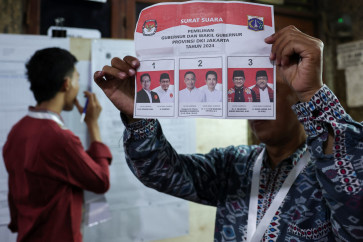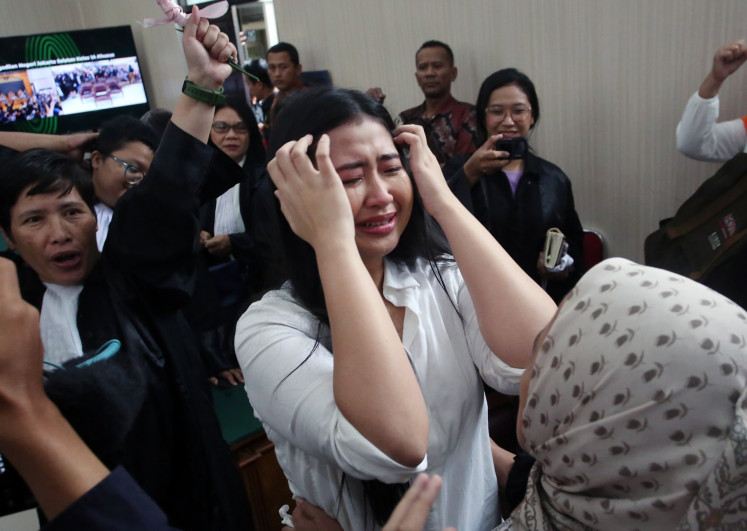Popular Reads
Top Results
Can't find what you're looking for?
View all search resultsPopular Reads
Top Results
Can't find what you're looking for?
View all search resultsMt. Sinabung, Mt. Kelud evacuees face hardships after return
Still cleaning up: Students at a public school in Kediri, East Java, sweep volcanic material from their classroom on Monday
Change text size
Gift Premium Articles
to Anyone
S
span class="caption">Still cleaning up: Students at a public school in Kediri, East Java, sweep volcanic material from their classroom on Monday. Kediri was one of the worst-affected areas when Mt. Kelud erupted on Feb. 13. Many schools were severely damaged, forcing temporary closures to allow for major repairs. Antara/Rudi Mulya
Thousands of residents who have returned to their villages after being evacuated due to the eruptions of Mount Sinabung in North Sumatra and Mt. Kelud in East Java have found their lives to be harder than ever.
More than 17,000 evacuees have reportedly not yet received aid in the form of living allowances that were earlier promised by the government, despite the fact that the residents, hailing from 16 villages, have been back in their houses ' located outside a 5-kilometer radius of the volcano ' for more than a week.
A resident of Sukandebi village, Sutresno Ginting, said his family no longer had adequate daily food supplies since returning home last week.
'We have used up our remaining supplies over the past week, so we hope the government will immediately provide living allowances for evacuees who have returned home,' Sutresno told The Jakarta Post in Sukandebi village on Monday.
He said, to date, the government had yet to distribute rations to Mt. Sinabung eruption evacuees who had returned home.
According to Sutresno, evacuees are in dire need of aid due to the current high costs of daily needs, particularly as they could not generate any income from their fields as crops have been damaged by volcanic ash.
He added that he had to fork out at least Rp 50,000 (US$4.3) for his children's transportation and schooling expenses. Fortunately, added Sutresno, he still had savings of Rp 300,000 that he received from donors and Rp 500,000 for working 10 days in the government-sponsored cash-for-work program.
Karo regency spokesman Jhonson Tarigan admitted the returning evacuees had yet to receive living allowances. According to him, the cash assistance is still being processed.
Jhonson added the cash assistance would be provided by the Social Affairs Ministry. 'Each person is entitled to Rp 6,000 and 0.4 kilograms of rice, daily for 30 days,' said Jhonson.
He added that as of noon on Monday, 17,150 people from 5,213 families had returned to their homes after living in shelters since the eruption occurred in September last year. Thirty people were killed as a result of the eruption.
Similar conditions were also experienced by thousands of evacuees from Pandansari village, Malang regency, East Java, who were living in a troubled state as they still lacked access to clean water and plastic tarpaulins to replace roofs that were damaged during the eruption of Mt. Kelud on Feb. 13.
Many of the residents have been forced to sleep in the open air. Some of them have even had to withstand rain due to heavy downpours in the area over the last two days.
Pandansari villagers, who claimed they had been forced to return home by authorities after taking shelter in a number of locations in Batu city since Feb. 21, said they were not yet ready to return home because the roofs of their homes had been virtually destroyed by the Mt. Kelud eruption.
'We are actually unprepared to leave the shelter because our homes in the village are ruined. We need tarpaulins to cover the roofs of our homes so we can be protected from the rain,' Pandansari villager Suyanto Bagong, 48, told the Post on Sunday.
Another villager, Ismail, 63, said he had only received two tarpaulin sheets measuring four-by-six meters from volunteers, though he needed four to five sheets to cover his roof.
'I have to borrow money to buy tarpaulins in Pujon district; if not my family will still have to withstand the rain and cold night air,' said Ismail.
Earlier, East Java Governor Soekarwo announced that around 16,000 families living in three regencies and municipalities affected by the Mt. Kelud eruption would receive housing aid.
The East Java provincial administration has earmarked Rp 100 billion from its budget to assist people displaced by the Mt. Kelud eruption, Rp 60 billion of which is derived from the housing program, while the remaining Rp 40 billion is from the unprecedented natural disaster budget.










